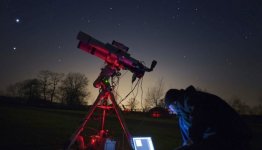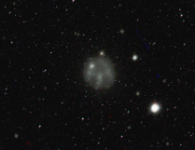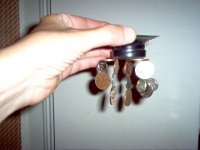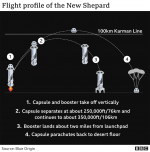Oh, I thought it was brought here after the formation of the Earth, not freed from the Earth's core.
Some of it has been stirred up, but that’s only a small part of the total amount in the Earth. Google it - quite a few references to it.
Like: How Is Gold Formed? Origins and Process...quite a few references to it.
The amount of gold extracted from the Earth is a tiny fraction of its total mass. In 2016 (it was) estimated 196,320 U.S. tons had been produced since the dawn of civilization. About 85% of this gold remains in circulation. Because gold is so dense it does not take up much space for its mass. In fact, if you melted all the gold mined to date, you'd wind up with a cube about 60 feet across!
Nevertheless, gold accounts for a few parts per billion of the mass of the Earth's crust. While it's not economically feasible to extract much gold, there are about 1 million tons of gold in the top kilometer of the Earth's surface. The abundance of gold in the mantle and core is unknown, but it greatly exceeds the amount in the crust.
I was quite wrong that South Africa produces most of the world's gold. These days China and Australia are the big producers.
It's a filthy business apparently. 30 tons of spoil for an ounce of gold. And the spoil is rich in toxic heavy metals. Also dangerous chemicals used in extraction, which frequently escape into the environment.
As Galu's link suggests, the total stockpile is currently around 171,300 Tonnes. A cube 20 metres across. This would fill 3 olympic swimming pools or cover a football pitch to a depth of 1 metre. A cubic metre of Gold weighs 19 Tonnes.
90% of it is apparently in bank vaults. Gold is currently £1300 an ounce. I make that a ton is worth £46M. Pharoah Tutankhamen's coffin apparently was 1.5 tons of gold. Hence all the tomb raiding historically.
It's a filthy business apparently. 30 tons of spoil for an ounce of gold. And the spoil is rich in toxic heavy metals. Also dangerous chemicals used in extraction, which frequently escape into the environment.
As Galu's link suggests, the total stockpile is currently around 171,300 Tonnes. A cube 20 metres across. This would fill 3 olympic swimming pools or cover a football pitch to a depth of 1 metre. A cubic metre of Gold weighs 19 Tonnes.
90% of it is apparently in bank vaults. Gold is currently £1300 an ounce. I make that a ton is worth £46M. Pharoah Tutankhamen's coffin apparently was 1.5 tons of gold. Hence all the tomb raiding historically.
South Africa used to produce the most but over the last 20 years, others have overtaken it. My great grandfather (originally from Cornwall) bought a tract of land in a place called Barberton because there were some alluvial deposits in the area, but soon discovered he’d only struck a little bit of gold and not the mother lode. The gold in SA is not alluvial (the bit that is there is just a trace so to speak where the seams come up). Most of it is buried deep down. Thousands were caught up but two guys, Cecil John Rhodes (the Kimberly diamond mining magnate) and Barney Banarto, an entrepreneur from London realized what was going on, and that huge amounts of capital were required to get the stuff out because you had to go deep. They quickly dominated the industry. My GGF eventually became a senior mining engineer at one of the big mines and was a founding member of the Institution of Mechanical Engineers over there.
(Apologies for the history digression 🙂 )
(Apologies for the history digression 🙂 )
No problems with that interesting link to your family history, Bonsai. 😎
My grandfather and both great grandfathers on my paternal side were also miners, but merely miners of coal.
My father once took me panning for gold in the Lowther Hills, but all we found in the burn was a dead sheep! 😱
In the 16th Century the area became important for the mining of gold. Mounds of debris or ‘gowd scaurs’ along the valleys testify to large scale working of the alluvial gravels during the reigns of James IV and V.
Gold from the Lowther hills was incorporated in the new crowns for King James V of Scotland and the Queen. Much of the gold coinage of King James V, and of his daughter Mary Queen of Scots, was minted in Edinburgh from gold from this area.
If you fancy your chances panning for gold, here's a guide: Gold Panning - The Lead Mining Museum
My grandfather and both great grandfathers on my paternal side were also miners, but merely miners of coal.
My father once took me panning for gold in the Lowther Hills, but all we found in the burn was a dead sheep! 😱
In the 16th Century the area became important for the mining of gold. Mounds of debris or ‘gowd scaurs’ along the valleys testify to large scale working of the alluvial gravels during the reigns of James IV and V.
Gold from the Lowther hills was incorporated in the new crowns for King James V of Scotland and the Queen. Much of the gold coinage of King James V, and of his daughter Mary Queen of Scots, was minted in Edinburgh from gold from this area.
If you fancy your chances panning for gold, here's a guide: Gold Panning - The Lead Mining Museum
Surprised you aren't out "panning" yourself tonight, Galu.
All this talk of meteorites reminded me of a strange fireball I saw about 5 years ago. Not your usual white or yellow, but GREEN! 😕
I along with hundreds of others did the dutiful thing and reported it to some Irish Observatory that keeps track of these things. Often security cameras pick them up too.
Anywhoo, I think the theory is this was a meteorite with high copper or nickel content. Which goes green in a flame. Standard chemistry identification.
Nickel is one of my favourite elements. My starsign (Taurus) is green too, so maybe that explains it.
Nickel salts are fabulous shades of green. Not many people know this, but Nickel is magnetic too. See below home experiment. It is also highly (occasionally fatally) toxic and has been voted the World's No.1 allergen. I noticed my girlfriends metal nose-stud seemed to inflame her nose a lot, but she never listened to me when I suggested she should lose it.
A certain Nickel company I worked PR for gave its process workers a fabulous deal. Free burial in the company graveyard! What they didn't tell the grieving widows, as they whipped the men's bodies away quickly, was the likely cause of death. 🙄
I am sure they have cleaned up their act now. 😀
All this talk of meteorites reminded me of a strange fireball I saw about 5 years ago. Not your usual white or yellow, but GREEN! 😕
I along with hundreds of others did the dutiful thing and reported it to some Irish Observatory that keeps track of these things. Often security cameras pick them up too.
Anywhoo, I think the theory is this was a meteorite with high copper or nickel content. Which goes green in a flame. Standard chemistry identification.
Nickel is one of my favourite elements. My starsign (Taurus) is green too, so maybe that explains it.
Nickel salts are fabulous shades of green. Not many people know this, but Nickel is magnetic too. See below home experiment. It is also highly (occasionally fatally) toxic and has been voted the World's No.1 allergen. I noticed my girlfriends metal nose-stud seemed to inflame her nose a lot, but she never listened to me when I suggested she should lose it.
A certain Nickel company I worked PR for gave its process workers a fabulous deal. Free burial in the company graveyard! What they didn't tell the grieving widows, as they whipped the men's bodies away quickly, was the likely cause of death. 🙄
I am sure they have cleaned up their act now. 😀
Attachments
Last edited:
Around 1994 or so I saw a large meteorite streak over my house in the summer afternoon, perfectly clear sky, sun still high. It was also green. Large enough to think it was quite low in the atmosphere. No sound. I was quite surprised there was nothing in the news about it. I watched it til it disappeared out of sight, about 5sec. or so. It was really big, or at least the fireball was. Amazing
There are only three elements that are ferromagnetic at room temperature: iron, cobalt and nickel.Not many people know this, but Nickel is magnetic too.
Nickel (like cobalt) produces a silver-white colour in a flame test and this may explain the colour of the majority of meteor trails.
Given the present clear skies over most of the UK, now's a good time for meteor spotting.
The Perseid meteor shower began on the 17th July and will continue until 12th August.
Each Perseid meteor is a particle no bigger than a grain of sand. The particles are released from comet Swift-Tuttle during its numerous returns to the inner solar system.
Details on how best to view the Perseids may be found here:
Perseid meteor shower UK: How to see the colourful light show in the sky - Birmingham Live
Attachments
My relationship with the Perseid meteor shower goes back to the summer camping holidays I took in the North of Scotland as a young man.
In those days, the road from the outskirts of the village to the campsite was unlit and I was guaranteed to see several meteor trails on my 15 minute walk back from the village pub.
Strange thing was, the trails always looked blurred!
In those days, the road from the outskirts of the village to the campsite was unlit and I was guaranteed to see several meteor trails on my 15 minute walk back from the village pub.
Strange thing was, the trails always looked blurred!

Attachments
@galu I've done astrophotography in the past. nights/weeks spent collecting data.
Those photos will be a stack of multiple long exposures, possibly with each colour channel being done separately.
In the photo above, it looks like there's some chromatic aberration. Unfortunately AP is unforgiving on optics quality.
This is me.. a while back.. one of my first star parties - a professional photographer friend at the event took it 🙂

I liked the challenge of small/dim objects that most scopes (ie a 4" scope) would have difficulty getting details from - both imaging in mono (higher resolution) and a lot of bespoke image processing after which I wrote software for:

That's the bearclaw, small and almost invisible unless you up the aperture.
Those photos will be a stack of multiple long exposures, possibly with each colour channel being done separately.
In the photo above, it looks like there's some chromatic aberration. Unfortunately AP is unforgiving on optics quality.
This is me.. a while back.. one of my first star parties - a professional photographer friend at the event took it 🙂

I liked the challenge of small/dim objects that most scopes (ie a 4" scope) would have difficulty getting details from - both imaging in mono (higher resolution) and a lot of bespoke image processing after which I wrote software for:

That's the bearclaw, small and almost invisible unless you up the aperture.
Last edited:
I'm a keen astrophotographer too. We get pretty dark skies here. Faint fuzzies are my passion too.. Got a computer controlled 14" schmidt cassegrain in the dome at the end of the garden!
This time of year it doesn't really get dark, not imaging season.
I love the perseids, but mid august has a bad habit of rain and cloud... However, a sun lounger repurposed in the garden is where I hope to be! That's actually a favourite location in darker months. It takes the eyes 30 minutes ish to fully adapt to darkness, but then the view of rthe starfield, milky way etc is magnificent. Suprising how sensitive the adapted eye, using averted vision is. (the most sensitive part of the eye is just off of the point you are "looking" at, there's a knack to a sort of sideways look)
This time of year it doesn't really get dark, not imaging season.
I love the perseids, but mid august has a bad habit of rain and cloud... However, a sun lounger repurposed in the garden is where I hope to be! That's actually a favourite location in darker months. It takes the eyes 30 minutes ish to fully adapt to darkness, but then the view of rthe starfield, milky way etc is magnificent. Suprising how sensitive the adapted eye, using averted vision is. (the most sensitive part of the eye is just off of the point you are "looking" at, there's a knack to a sort of sideways look)
Astrophotography is an interesting pursuit, Nick and gpauk.
It's amazing the results that amateurs can obtain with the equipment now at their disposal.
My knowledge of the techniques involved is limited to what has been demonstrated on "The Sky at Night" programme!
Happy meteor and faint fuzzy spotting! 😎
It's amazing the results that amateurs can obtain with the equipment now at their disposal.
My knowledge of the techniques involved is limited to what has been demonstrated on "The Sky at Night" programme!
Happy meteor and faint fuzzy spotting! 😎
Bezos takes the rise out of Branson by crossing the Karman line! 
Jeff Bezos launches to space aboard New Shepard rocket ship - BBC News

Jeff Bezos launches to space aboard New Shepard rocket ship - BBC News
Attachments
Nice article on the JWST here
Why NASA’s James Webb Space Telescope Will Never Live As Long As Hubble
Why NASA’s James Webb Space Telescope Will Never Live As Long As Hubble
And some more interesting stuff
A Fascinating Animation Demonstrating the Gravitational Pull of Solar System Bodies
A Fascinating Animation Demonstrating the Gravitational Pull of Solar System Bodies
I'm a keen astrophotographer too. We get pretty dark skies here. Faint fuzzies are my passion too.. Got a computer controlled 14" schmidt cassegrain in the dome at the end of the garden!
I put in a 3/4 ton concrete pier in the garden but unfortunately job and home life has changed so I've ended up removing it as part of the agreement to make moved pond a larger blockwork installation.
Just a Pentax 105SDP, image field is flat as a pancake using 2" filters and off-axis guiders along with a collection of CCD mono cameras. Also have televise 2x and 5x so the max I can get out of the old gal is 6400mm focal length but only for sunspot with sun film over the front. The double doublet design of the SDP means I can't put a proper sun filter and wedge on it or I'll end up cracking the rear optics.
The software I wrote simply uses, and records, the guide star images through the off axis guider. Then it's a scope point spread function for the OTL and then atmosphere point spread function deconvolution. It gives a more nuanced deconvolution than using the stars in the long exposure.
No different to electronics signal deconvolution just in 2D - which even X&Y are simply multiplied it's relatively simple.
I was also experimenting with non-uniform deconvolution using FFT phase corellation and 3D deconvolution - almost like one exposure-multiple focus focusing of microscopes - just in telescopes.
I'll be getting round to opening your links later, Bonsai. 😎And some more interesting stuff...
- Status
- Not open for further replies.
- Home
- Member Areas
- The Lounge
- What is the Universe expanding into..



